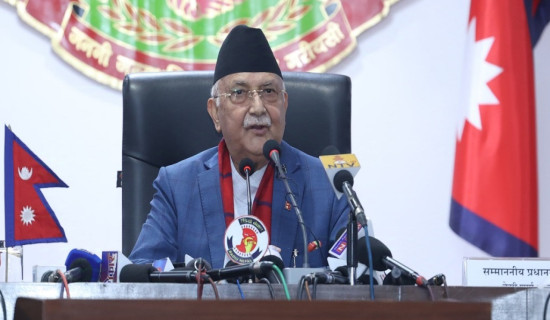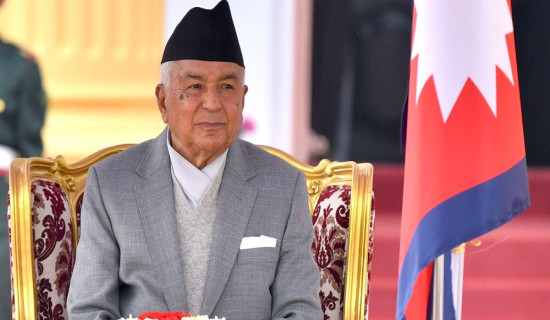- Thursday, 29 May 2025
The Ambassador's Dog: Lo Khyi
Janaki Kumari Sharma
There are many literary figures who open up about their feelings for their pets. Currently, more than 70,000 dog books are listed on Amazon. Among them, the dog mind is an increasingly prominent feature of literary fiction (The New York Times, 2019).
However, Scott H. DeLisi, who served as a diplomat for 35 years, has a different story to tell about the puppy, who is a magical, wise, and mysterious incarnation.
During his ambassadorial career, he also served as U.S. Ambassador to Nepal and met a little puppy on a trail in Upper Mustang and adopted him. The book, The Ambassador's Dog, includes the subtle feelings and emotions of Lo Khyi, a Tibetan plateau-born dog whose destiny and dreams take him on an ambassadorial journey far from his birthplace.
The story begins with a lost, tiny puppy in the village of Tsarang, high in the mountain region of Nepal, who is too young to figure out what is going on with him. Despite the harsh, freezing winter and the absence of loving family members, he is alive on that plateau, living his dreams.
After some freezing days, a miracle happens in the life of that little puppy. A young boy named Karkung rescues him and takes him home. With that, he gets a shelter to live in and abundant food to eat. However, he seems restless with those accommodations and hospitality, as he senses that none of them is the family that he had dreamed of. People in the Saukre village become worried that this handsome dog might leave them permanently as they discover his wandering spirit.
One day, a man encounters him at the place where he gazes down the trail that leads back to Tsarang for the arrival of someone. Both of them stare at each other and talk to each other. The puppy confirms that this is the man: Scott, whom he has been waiting for. He also conveys his feelings to Scott to assure him that he has been waiting since his birth. He further whispers that he belongs to him. However, the ambassador cannot realise the blue-eyed puppy that has been desperately waiting for him.
Then, Scott sets off on his journey up the hill to the monastery, the last destination of his journey with his company. His thoughts are immediately drawn to the puppy. Sparking blue eyes take his breath away when he thinks of the conversation between them and the gesture of that dog. Scott soon maps down the hill to "Saukre," where the dog has been waiting for him as usual.
On the way, he meets Wangdi, Kerchung's uncle, and asks everything about that puppy. Wangdi explains the history of that puppy and his wandering spirit. When Scott asks if they would sell that puppy, Wangdi refuses and states that dogs in Tibet are the source of happiness. So, they do not sell them but can offer the puppy to Scott as a gift.
The little, handsome puppy happily agrees to go along with Scott and explore the ambassadorial realm. Scott keeps the dog's name as "Lo khyi," which means "a source of happiness," and the dog gratefully accepts it as a gift and a sign of Scott's love. With the new sunlight, both of them mapped out a further voyage from the mountain. The Himalayan-born dog now happily lives in Virginia, USA.
Personally, I found the book to be a brief, poignant story that conveys a sweeping sense of love and feeling and radiates humanism. I wonder how someone can express every detail of their feelings so minutely. This book is also an amalgamation of many philosophies, for instance, optimism, humanism, Buddhism, the illustration and use of so many incidents, and spiritualism.
Humanism is the main spirit that is carried out in the book. Karchung rescued the dog who was wrestling with life and death, snuggled him like a human child, and took him home. This incident provokes the thought of how generous the Himalayan people are despite their meagre economic conditions. Similarly, the connection between a Nepalese Himalayan heart and an American heart became possible only because of humanism, love, and empathy. Compassion has brought meaningful hope and possibilities of completion into the little puppy’s life.
Moreover, the book has shown an optimistic perspective in general. Despite the harsh conditions, the little puppy never tyres of dreaming and being alive.He believes that one day his prayers will be granted from heaven. And, ultimately, his dreams come true. The writer asks us to be optimistic though we may go through unprecedented conditions, presenting the dog as a determined believer.
When you want something, the universe conspires to help you get it, according to Paulo Coelho. The use of this postulation can be found widely in the book. To illustrate, the writer has used wind waves as a medium to transform a dog's dreams and prayers into the ambassador by unknowingly igniting the love in his heart.
Just like John Muir thinks the mountains are calling him, he believes this love might have dragged him to the Himalayan region. These sorts of epitome have made a book more readable and reflect the writer's conscious reverence toward nature.
The conversation between the author and little Puppy unfolds many mysteries. There's no doubt that some animals can understand human languages if they're close enough. Dogs, cats, some birds, horses, and probably other mammals can understand words and gestures. However, the talk between the ambassador and the puppy, who have never met before, is beyond imagination, which will push you toward thinking of how you can talk and understand the languages of that dog. I reckon that they (the writer and puppy) might have had a connection with something in their previous lifetime.
The writer has used language poignantly so that we can feel every word so deeply. The development of the story with illustrations cultivates a unique peace in readers' minds, even though the early story of an orphaned dog makes readers anxious, making them wonder what will happen to that little puppy. The expression of feelings in a poetic sense and the use of metaphors are other praiseworthy qualities of the writer.
In conclusion, the book contains the journey of a little puppy from Saukre to the ambassadorial world. We can explore many dimensions in the book, such as humanism, optimism, and the use of poetic language.
(Sharma is a lecturer of Public Administration)
















